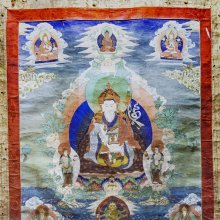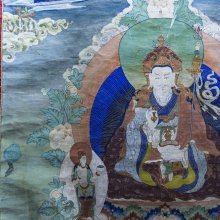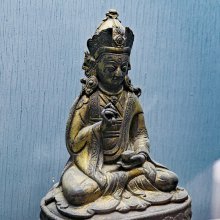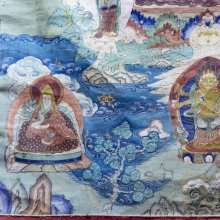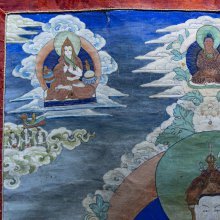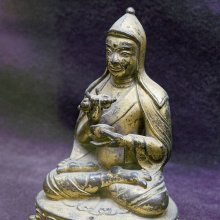Padmasambhava, Padmasaṃbhava, Padma-sambhava: 11 definitions
Introduction:
Padmasambhava means something in Buddhism, Pali, Hinduism, Sanskrit, the history of ancient India. If you want to know the exact meaning, history, etymology or English translation of this term then check out the descriptions on this page. Add your comment or reference to a book if you want to contribute to this summary article.
Images (photo gallery)
(+9 more images available)
In Buddhism
Tibetan Buddhism (Vajrayana or tantric Buddhism)
Source: Wisdom Library: Tibetan BuddhismPadmasambhava (पद्मसम्भव) is the name of a Pratyekabuddha mentioned as attending the teachings in the 6th century Mañjuśrīmūlakalpa: one of the largest Kriyā Tantras devoted to Mañjuśrī (the Bodhisattva of wisdom) representing an encyclopedia of knowledge primarily concerned with ritualistic elements in Buddhism. The teachings in this text originate from Mañjuśrī and were taught to and by Buddha Śākyamuni in the presence of a large audience (including Padmasambhava).
Source: WikiPedia: Tibetan Buddhism
Padmasambhava[note 1] (lit. "Lotus-Born"), also known as Guru Rinpoche, often fondly referred to by Tibetans as the 'Second Buddha,' and revered as the person who placed Buddhism on a sound footing in Tibet. Although there was a historical Padmasambhava, nothing is known apart from him helping the construction of a temple at Samye at the behest of Trisong Detsen and shortly being chased out of Tibet.
Padmasambhava is a literary character of terma, an emanation of Amitabha that is said to appear to tertons in visionary encounters and a focus of Tibetan Buddhist practice.
According to tradition, Padmasambhava was incarnated as an eight-year-old child appearing in a lotus blossom floating in Lake Dhanakosha, in the kingdom of Oḍḍiyāna in Ancient India and in modern times identified with the Swat Valley of South Asia present-day Pakistan. His special nature was recognized by the childless local king of Oḍḍiyāna and was chosen to take over the kingdom, but he left Oḍḍiyāna for northern parts of India.

Tibetan Buddhism includes schools such as Nyingma, Kadampa, Kagyu and Gelug. Their primary canon of literature is divided in two broad categories: The Kangyur, which consists of Buddha’s words, and the Tengyur, which includes commentaries from various sources. Esotericism and tantra techniques (vajrayāna) are collected indepently.
General definition (in Buddhism)
Source: Shambala Publications: GeneralPadmasambhava Skt., lit., “the Lotus-born”; contemporary of the Tibetan king Trisong Detsen (755–97) and one of the historically identifiable founders of Tibetan Buddhism. He left his imprint particularly on the Nyingma school and is venerated by its followers as the “second Buddha.” His special task lay in taming the indigenous demons, or the forces of nature embodied in them. The methods of Padmasambhava ranged from the use of ritual implements, such as the phurba, to the mastery of the meditation techniques of dzogchen. In the course of centuries, the figure of Padmasambhava, who continued the tradition of the mahāsiddhas, took on an increasingly legendary character. He is still venerated today in the Himalayan countries under the name Guru Rinpoche (Precious Guru).
Source: WikiPedia: BuddhismPadmasambhava (lit. "Lotus-Born"), also known as the Second Buddha, was a sage guru from Oddiyana, northwestern Classical India (in the modern-day Swat Valley of Khyber Pakhtunkhwa, Pakistan). Padmasambhava is said to have transmitted Vajrayana Buddhism to Tibet, Bhutan and neighboring countries in the 8th century AD. In those lands, he is better known as Guru Rinpoche (lit. "Precious Guru") or Lopon Rinpoche, or as Padum in Tibet, where followers of the Nyingma school regard him as the second Buddha.
India history and geography
Source: academia.edu: The Chronological History of Tibetan BuddhismPadmasambhava, the second Buddha vs Padmasambhava, the disciple of Shrisimha.—Modern historians have mistakenly considered Padmasambhava, the disciple of Shrisimha as the founder of the Nyingma tradition and propagated that Tibetan Buddhism has the history starting from the 8th century. In reality, Padmasambhava, the second Buddha was none other than Bodhisattva Vajrapani or Samantabhadra who lived around 1641-1541 BCE whereas Padmasambhava, the disciple of Shrisimha visited Tibet during the reign of Tibetan King Trisong Detsan (82-137 CE).

The history of India traces the identification of countries, villages, towns and other regions of India, as well as mythology, zoology, royal dynasties, rulers, tribes, local festivities and traditions and regional languages. Ancient India enjoyed religious freedom and encourages the path of Dharma, a concept common to Buddhism, Hinduism, and Jainism.
Languages of India and abroad
Sanskrit dictionary
Source: DDSA: The practical Sanskrit-English dictionaryPadmasaṃbhava (पद्मसंभव).—epithets of Brahman, the lotus-born god.
Derivable forms: padmasaṃbhavaḥ (पद्मसंभवः).
Padmasaṃbhava is a Sanskrit compound consisting of the terms padma and saṃbhava (संभव). See also (synonyms): padmaja, padmajāta, padmabhava, padmabhū, padmayoni.
Source: Cologne Digital Sanskrit Dictionaries: Benfey Sanskrit-English DictionaryPadmasaṃbhava (पद्मसंभव).—adj., m. epithet of Brahman, [Harivaṃśa, (ed. Calc.)] 3233.
Padmasaṃbhava is a Sanskrit compound consisting of the terms padma and saṃbhava (संभव).
Source: Cologne Digital Sanskrit Dictionaries: Cappeller Sanskrit-English DictionaryPadmasaṃbhava (पद्मसंभव).—[masculine] = padmaja.
Source: Cologne Digital Sanskrit Dictionaries: Monier-Williams Sanskrit-English Dictionary1) Padmasambhava (पद्मसम्भव):—[=padma-sambhava] [from padma] m. = -ja, [Harivaṃśa]
2) [v.s. ...] Name of a Buddhist teacher who founded the Red sect in Tibet, [Monier-Williams’ Buddhism 272 etc.]
[Sanskrit to German]
Sanskrit, also spelled संस्कृतम् (saṃskṛtam), is an ancient language of India commonly seen as the grandmother of the Indo-European language family (even English!). Closely allied with Prakrit and Pali, Sanskrit is more exhaustive in both grammar and terms and has the most extensive collection of literature in the world, greatly surpassing its sister-languages Greek and Latin.
See also (Relevant definitions)
Partial matches: Padma, Shambhava.
Full-text (+8): Bardo Thodol, Shambhava, Abjasambhava, Samantabhadra, Uddiyana, Padmabhu, Padmajata, Padmabhava, Padmayoni, Padmaja, Nyingma, Wular, Trisong Detsen, O-rgyan, U-rgyan, Kayamandala, Pacham, Vajrapani, Ura, Nyingmapa.
Relevant text
Search found 22 books and stories containing Padmasambhava, Padmasaṃbhava, Padma-sambhava, Padma-saṃbhava; (plurals include: Padmasambhavas, Padmasaṃbhavas, sambhavas, saṃbhavas). You can also click to the full overview containing English textual excerpts. Below are direct links for the most relevant articles:
Brihad Bhagavatamrita (commentary) (by Śrī Śrīmad Bhaktivedānta Nārāyana Gosvāmī Mahārāja)
Verse 1.2.67-71 < [Chapter 2 - Divya (the celestial plane)]
Blue Annals (deb-ther sngon-po) (by George N. Roerich)
Chapter 6 - First incarnation series (i): dus gsum mkhyen pa < [Book 8 - The famous Dakpo Kagyü (traditions)]
Chapter 10 - Phagmodru lineage (i): spyan snga < [Book 8 - The famous Dakpo Kagyü (traditions)]
Chapter 1 - Shri System (ii): The Lineage of thug rje chen po < [Book 14 - Great Compassion Cycle]
The Way of the White Clouds (by Anāgarika Lāma Govinda)
Chapter 11 - The Rock Monastery < [Part 1 - Three Visions]
Chapter 52 - The Happy Valley < [Part 4 - Return to Western Tibet]
Chapter 53 - Final Initiations < [Part 4 - Return to Western Tibet]
Lord Hayagriva in Sanskrit Literature (by Anindita Adhikari)
History and Temples < [Chapter 6]
The gods of northern Buddhism (by Alice Getty)
Guhyagarbha Tantra (with Commentary) (by Gyurme Dorje)
